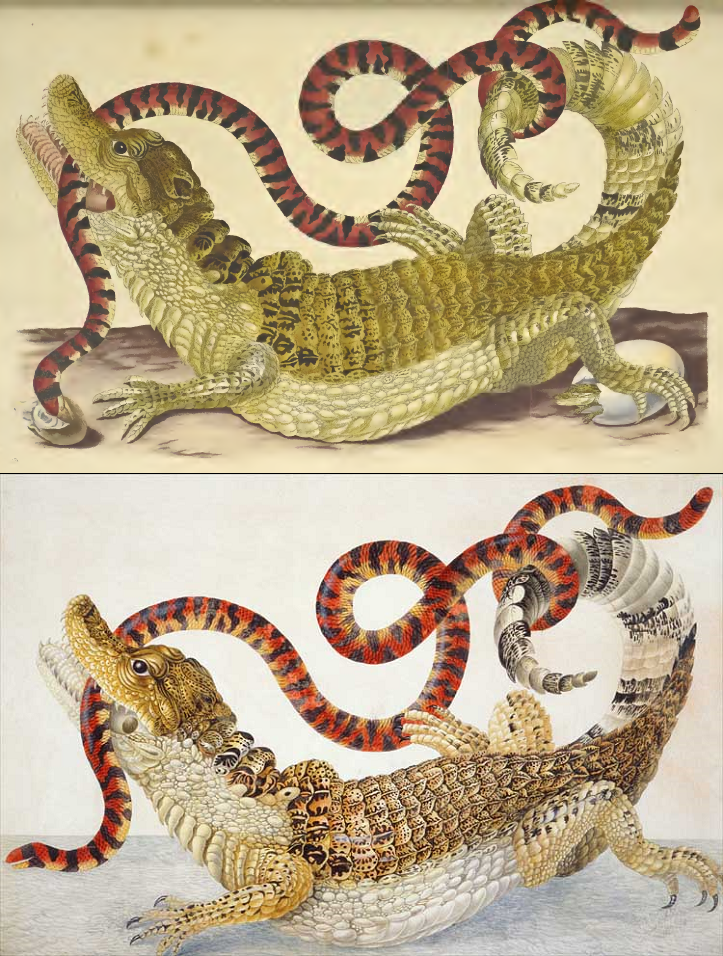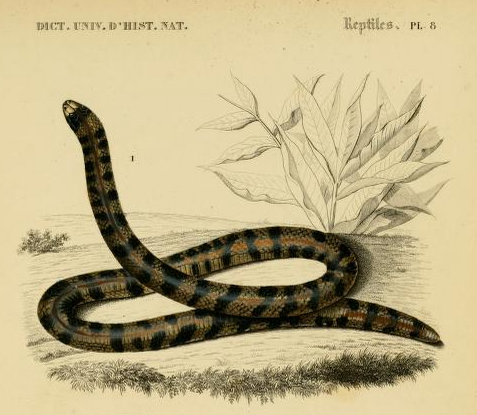This post will soon be available in Spanish
 |
| Anilius scytale, the only living member of the family Aniliidae, one of only two snake families containing just a single species |
Deep in the Amazon rain forest there lives a fairly small, fairly obscure, red and black snake called Anilius scytale. It is banded, like many red and black snakes, but it has no venom, so it may be a coralsnake mimic. It spends most of its time under ground or in the water. Morphologically, it has a mixture of characteristics that place it somewhere in the no-man's-land we call "henophidia"—it has pelvic vestiges like many boas and pythons, but it has a small gape and is not capable of eating large bulky prey. It mostly feeds on elongate vertebrates, including other snakes, amphisbaenians, caecilians, and eels, and like other snake-eating snakes individuals can eat prey approaching their own total length. Its ventral scales are only barely wider than its dorsal scales, and it has just a few enlarged head scales, including one large hexagonal scale covering the eye and the surrounding skin. Males are smaller than females, which are viviparous, capable of giving birth to as many as 24 live young at a time. In 1946, the great naturalist William Beebe wrote "This is a strange snake", meaning that it's not quite like any other snakes. It is alone in its family, Aniliidae.
 |
| Head of Anilius showing the large scale covering both the eye and the surrounding skin, like blindsnakes but unlike most heno- and caenophidians |
Snake biologists have used the term "pipesnake" to refer to any of three different lineages of snakes: the cylindrophiids (10 species of "Asian pipesnakes"), anomochilids (3 species of "dwarf pipesnakes"), and aniliids (1 species of "red pipesnake"; i.e., Anilius scytale). I'd like to propose that we begin to think of Anilius as "the pipesnake that wasn't", because (as I alluded to last month), it is now thought to be most closely related to tropidophiids (aka "the boas that weren't), superficially boa-like snakes found mostly in the Caribbean. Molecular data and some morphological data, especially that of the soft anatomy of the lungs and reproductive system, suggests that these two groups are each others' closest relatives, and they are now placed together in the Amerophidia (aka Anilioidea), the basal-most lineage of alethinophidia, which was apparently isolated in South America during the split-up of west Gondwana. Details of the skull anatomy cast some doubt on this classification, suggesting a closer relationship between aniliids and other non-macrostomatan pipesnakes, although even if this is true there are undoubtedly deep splits between Anilius and any other living snakes. Like the tuatara and the coelacanth, Anilius has not had close living relatives for tens of millions of years. Only it knows if it's lonely out there on such a long branch of the snake family tree.
 |
| Top: The plate of Anilius and a caiman as it appeared in the 1719 printing of Merian's Metamorphosis Insectorum Surinamensium Bottom: A later version of the plate, recolored and with the eggs removed |
If Anilius is lonely, it can take some solace from having been noticed and beautifully illustrated by one of the first ecologists, Maria Sibylla Merian. Merian was a remarkable artist and scientist who lived from 1647 to 1717. She was one of the first trained artists to conduct detailed, long-term studies of living organisms, and the first published female naturalist. Most of her drawings, which she sketched from life on vellum and later engraved herself on copper plates, depict the life cycles of insects and their plant hosts, which she raised in captivity. She was the first to document that caterpillars turned into butterflies, and she described the life cycles of hundreds of insects, amassing evidence that contradicted the then-widespread notion that insects were "born of mud" by spontaneous generation (although others were credited with this discovery for a long time because her work was largely ignored, because it was written in Dutch rather than Latin). In 1699, Merian and her fifteen year-old daughter traveled to Surinam, where they spent the next two years studying and drawing the indigenous animals and plants, including several snakes. Her most famous work, Metamorphosis Insectorum Surinamensium, contains plates of many of these snakes, including one of an Anilius eating the egg of a caiman and being simultaneously attacked by the adult crocodilian. Like most of her drawings, it shows aspects of the natural history and ecology of the organisms in it, and helped establish a style of scientific illustration that later inspired naturalists from Catesby to Audubon. She depicted most of her insects life-sized, from various angles, in all stages of their life cycles, and most importantly, interacting with their host plants and predators. Her observations of animal behavior and plant-animal interactions are so detailed that many consider her the first ecologist. Considering that she died when Linnaeus was only 10 years old, it is all the more remarkable that her writings and drawings emphasize where organisms live and what they do rather than how they should be classified. Her works became very popular among Europe's upper class, and Czar Peter the Great in particular purchased many of her original watercolors and recruited her daughter as an art advisor and teacher at the newly-founded Academy of Arts in St. Petersburg. The Argentine Black and White Tegu, Tupinambis merianae, is named after her. Merian's text has not been translated into English, but I have taken a stab at translating her paragraph about snakes here:
Like crocodiles, some snakes hatch from eggs. They lay many small ones. The head and the tail of this snake, the Amphisbona, are the same shape and size, but you can tell which is the head because it has a mouth and small eyes, whereas the tail does not. Of all snakes, this one is the cleanest in color, being black, red, and yellow; others are grayish white, yellow, and brown with bodies that are more flattened.
ACKNOWLEDGMENTS
Thanks to Patrick Campbell and Andrew Snyder for allowing me to use their images.
REFERENCES
 |
| Anilius from d'Orbigny's 1849 Dictionnaire Universel d'Histoire Naturelle |
Duellman, W.E. 1978. The biology of an equatorial herpetofauna in Amazonian Ecuador. Miscellaneous Publications, Museum of Natural History, University of Kansas 65:1-352 <link>
Etheridge, K. 2011. Maria Sibylla Merian: The First Ecologist. in V. Molinari and D. Andreolle, editors. Women and Science: Figures and Representations – 17th century to present. Cambridge Scholars Publishing, Newcastle upon Tyne <link>
Marques, O. A. V. and I. Sazima. 2008. Winding to and fro: constriction in the snake Anilius scytale. Herpetological Bulletin 103:29-31 <link>
Martins, M. and E. M. Oliveira. 1998. Natural history of snakes in forests of the Manaus region, Central Amazonia, Brazil. Herpetological Natural History 6:78-150 <link>
Maschio, G. F., A. L. da Costa Prudente, A. C. de Lima, and D. T. Feitosa. 2007. Reproductive biology of Anilius scytale (Linnaeus, 1758) (Serpentes, Aniliidae) from eastern Amazonia, Brazil. South American Journal of Herpetology 2:179-183 <link>
Maschio, G. F., A. L. C. Prudente, F. S. Rodrigues, and M. S. Hoogmoed. 2010. Food habits of Anilius scytale (Serpentes: Aniliidae) in the Brazilian Amazonia. Zoologia (Curitiba, Impresso) 27:184-190 <link>
Merian, M.S. 1719. Metamorphosis Insectorum Surinamensium. Joannes Oosterwyk, Amsterdam <link>
Pieters, F. F. J. M. and D. Winthagen. 1999. Maria Sibylla Merian, naturalist and artist (1647-1717): a commemoration on the occasion of the 350th anniversary of her birth Archives of Natural History 26:1-18 <link>
Sawaya, R. J. 2010. The defensive tail display of Anilius scytale (Serpentes: Aniliidae). Herpetology Notes 3:249-250 <link>
Life is Short, but Snakes are Long by Andrew M. Durso is licensed under a Creative Commons Attribution-NonCommercial-NoDerivs 3.0 Unported License.
